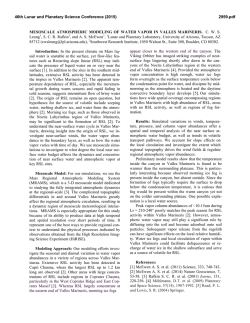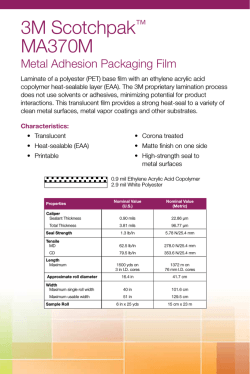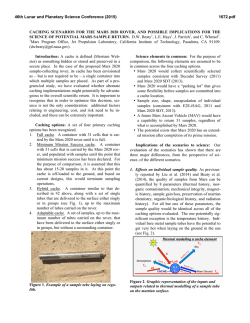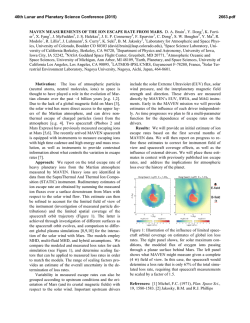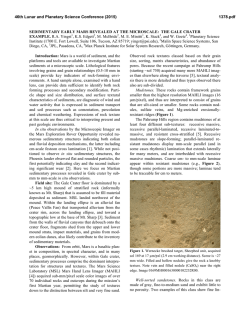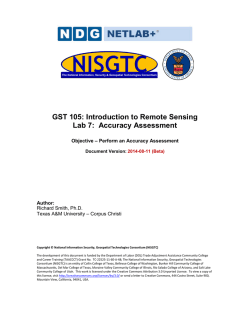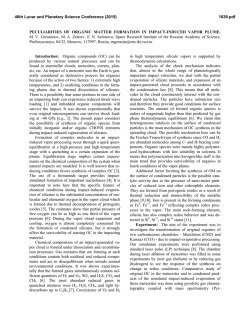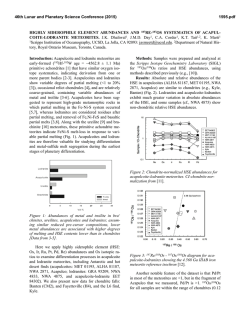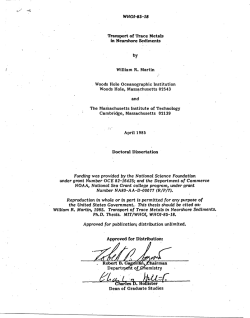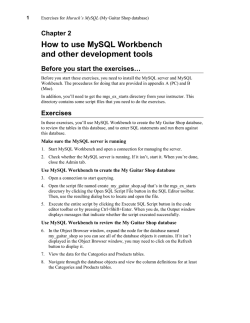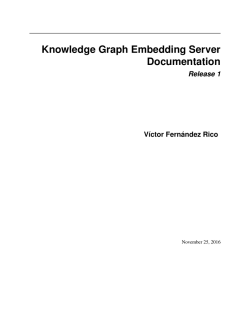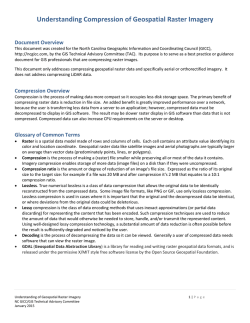
RESTORATION OF VIKING MAWD DATASET. R. G. Nuno, D. A.
46th Lunar and Planetary Science Conference (2015) 2639.pdf RESTORATION OF VIKING MAWD DATASET. R. G. Nuno, D. A. Paige, M. Sullivan, Department of Earth, Planetary, and Space Sciences, University of California Los Angeles, Los Angeles, CA 90095 ([email protected]) Introduction: High-resolution HIRISE images of transient albedo dark features, called Recurring Slope Lineae (RSL), have been interpreted to be evidence for current hydrological activity [1]. If there are surface sources of water, then localized plumes of atmospheric water may be observable from orbit. The Viking Mars Atmospheric Water Detector (MAWD) column water vapor data are uniquely valuable for this purpose because they cover the full range of Martian local times, and include data sampled at high spatial resolution [2]. We searched the raster-averaged Viking Orbiter 1 and 2 MAWD column water vapor dataset for regions of localized elevated column water vapor abundances and found mid-latitude regions with transient water observations [3] (Fig 1). Our objective is to determine if the elevated column water abundances observed in the raster-averaged MAWD dataset were due to a single elevated raster measurement (implying a localized source) or to all 15 raster measurements having elevated column water vapor abundances (implying a more regional source). Figure 1. Points of interest, differentiated by green and pink makers for north and south hemispheres respectively, over Mars albedo map. Points with elevated H2O column abundances are seen predominately in albedo dark regions. Viking Orbiters MAWD: The raster averaged Viking Orbiter 1 and 2 MAWD column water vapor data available in the Planetary Data System (PDS), were calculated from radiance measurements using seasonally and topographically varying surface pressures which, at the time, had high uncertainties [4]. Due to recent interest in transient hydrological activity on Mars [2], we acquired and decoded the available portion of the non-raster averaged Viking Orbiter 1 MAWD data, which are sampled at 15 times higher spatial resolution than the data currently available from PDS, to determine the occurrence of localized water vapor on Mars. Figure 2. a) Projection of a MAWD field of view (FOV) onto the surface of Mars, from an altitude of 1500 km, b) Theoretical water vapor spectra; spectral positions of the 5 detector channels are indicated by the number 1-5 [4]. Spectral Fitting: Least Squares Fit. We derived a rudimentary proxy to column water vapor abundance by performing a least squares fit to the mean of the radiances of 15 raster observations with little spatial and temporal variation. Calculated mean radiance values of 15 individual raster radiance measurements, per channel, of a single instantaneous FOV (IFOV) observation. This particular IFOV observation was chosen because it showed elevated column water vapor abundances in the raster-averaged MAWD dataset, and the measurements were taken over approximately the same area and time. The mean values, and a constant offset, were used as basis functions to derive a scalar for the functions that was used as a proxy for column water vapor abundance for each raster observation. Discussion: We are acquiring the Viking Orbiter 2 MAWD dataset to recalculate column water vapor abundances using current topographical data, as well as dust and pressure measurements from the Mars Global Circulation Model. References: [1] McEwen, A. S., et al. (2011). Seasonal flows on warm Martian slopes. Science (New York, N.Y.), 333(6043), 740–3. [2] Farmer, C. B., & Laporte, D. D. (1972). The Detection and Mapping of Water Vapor in the Martian Atmosphere. Icarus. [3] Nuno, R. G., et al. (2013). Searching for Localized Water Vapor Sources on Mars Utilizing Viking MAWD Data. 44th Lunar and Planetary Science Conference. [4] Farmer, C. B., et al. (1977). Mars: Water vapor observations from the Viking orbiters. Journal of Geophysical Research, 82(28), 4225–4248.
© Copyright 2025

